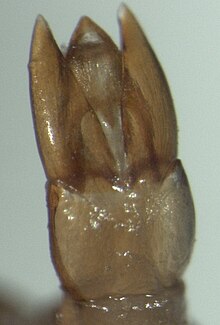插入器
此條目需要补充更多来源。 (2014年4月1日) |

插入器(學名:aedeagus),又名交尾刺、中葉突,陽莖器等,是雄性節肢動物 (主要是昆蟲)的生殖器,與雌性動物交配時透過插入器來分泌由睪丸產生的精子。這個器官可以類比哺乳類動物的陰莖,儘管插入器的構造其實更為複雜。部分昆蟲的插入器有莢包裹,就好像陰莖的包皮那樣,但不叫「陰莖」,而是叫作「陽莖」。
語源
[编辑]「插入器」的學名「aedeagus」源於古希臘語的η αιδώς(aidos)或το αιδοίον(aidoion)、眾數作τα αιδοία(aidoia)。
解剖構造
[编辑]插入器是雄性昆蟲腹部的一部分,即其整個身體三個主要部分的最後方的部分。插入器有生殖管連接往其體內的一對睪丸。插入器是雄性昆蟲的陽莖的部分,其構造複雜,而且不同物種間會有不同的排列方式。 complex and often species-specific arrangement of more or less sclerotized (hardened) flaps and hooks which also includes in some species the valvae (clasper), which are paired organs which help the male hold on to the female during copulation. During copulation, the aedeagus connects with the ovipore of a female. The aedeagus can be quite pronounced or de minimis.
The base of the aedeagus may be the partially sclerotized phallotheca, also called the phallosoma or theca. In some species the phallotheca contains a space, called the endosoma (internal holding pouch), into which the tip end of the aedeagus may be withdrawn (retracted). The vas deferens is sometimes drawn into (folded into) the phallotheca together with a seminal vesicle.[1][2]
节肢动物的精子往雌蟲傳送時不會以液態 with free-swimming spermatozoa傳送,而是contains capsules called spermatophores in which the actual spermatozoa are enclosed. In addition to the spermatophores, in some species the aedeagus also discharges a spermatophylax, a ball of 精弓nutritious secretions to aid the female in producing offspring.
鱗翅目的大多數雄性物種,其插入器均有鞘, which is supported by an organ called the juxta, which is located between the aforementioned valvae.
參看
[编辑]- 蜘蛛的觸肢可作交配用
參考文獻
[编辑]- ^ De Carlo, J. A. Hemipteros acuáticos y semiacuáticos. Estudio en grupos en las partes de igual función de los aparatos genitales masculinos de especies estudiadas. Revista de la Sociedad Entomológica Argentina. 1983, 42 (1/4): 149–;154.
- ^ Andersen, N. Møller. Marine insects: genital morphology, phylogeny and evolution of sea skaters, genus Halobates (Hemiptera: Gerridae). Zoological Journal of the Linnean Society. 1991, 103 (1): 21–60. doi:10.1111/j.1096-3642.1991.tb00896.x.
